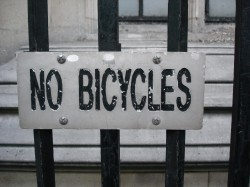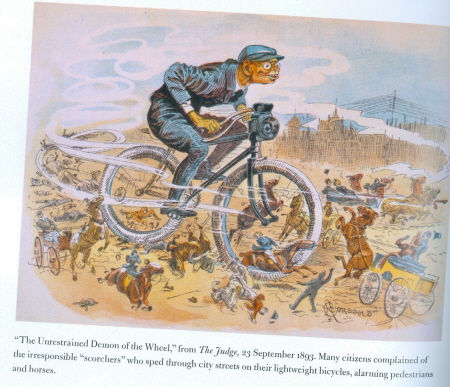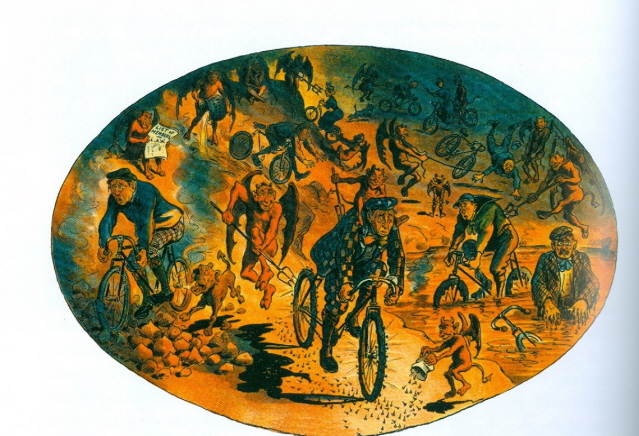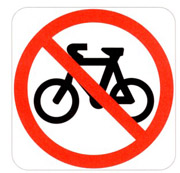 superstock.com
superstock.com
The bicycle is no where near short of antagonists—those who refuse to ride the machine, are against others riding the machine, wish for the demise of the machine. This group of opponents has existed since the invention of the bicycle, some protesting against it actively while others quietly dislike its riders. However it is this opposition which defines the bicycle and identifies it as a the tool for social change that so many examples in time and space support. Dr. Steve Yamaguchi of Los Ranchos Presbyterian Church speaks on the importance of antagonism. He begins with the analogy regarding muscles used in cycling. It is necessary to have muscles in our legs that pull in opposite directions in order to create the force to allow for the motion of the bicycle. Antagonistic forces between individuals serves a similarly necessary function. Yamaguchi says, “we need antagonists to survive. We need them to be mobile and effective.”
Then...
Upon the first few decades of the invention of the bicycle, first the Penny-farther and then the Safety bicycle, there were many who were opposed to their proliferation. The satisfaction in which riders sat upon their high saddles, created a separation and bitterness in pedestrians. Many believed this literal increase in height that the bicycle gave its riders was mirrored by a sense of haughty grandeur and importance. This may be contributed to the relatively high cost of the bicycle and select few who could afford to own one.
Pedestrians and coach riders would often shout chastising chants to bikers as seen in the image below. These were only harmless locutions, “but when to words are added deeds, and stones are throne, sticks thrust into the wheels, or caps hurled into the machinery, the picture has a different aspect” (Bijker 41). It was not uncommon for a fight to break out between a bicycle rider a coach driver.
Women riding bicycles was of specific controversy primarily in the early years of the bicycle, however, lingering decades later. In this sense, the bicycle was a radical tool inducing major changes in society. For some, these alterations in gender roles, with the bicycle as the root, was unacceptable. Even those who were in support of women riding bicycles, including feminists of the time, were against women racing and still believed a proper costume must be warn. Opposition slowed down the triumph over women’s rights, but powered the bicycle to pedal even harder as a tool to create change.
 "Bicycle: The history, By David Herlihy
"Bicycle: The history, By David Herlihy
 "A vision of bicycle hell, from Puck, 21 july 1897, contemplating the fate of nonobservant bicyclists who spent their Sundays in the saddle rather than in a pew"
"A vision of bicycle hell, from Puck, 21 july 1897, contemplating the fate of nonobservant bicyclists who spent their Sundays in the saddle rather than in a pew"
...And Now
Harvard prohibits bicycles in Harvard Yard and many other central spots of Cambridge and campus. What does this say about the bicycle if one of the most well-endowed, most elite universities in the country prohibits its use?
Even other cyclists often express frustration regarding ridership. Because bicycle owners exist at such a range of skill levels and interests, those at each extreme, professional versus purely recreational, lose the ability to relate. This may result in a disregard for the riding motives and behaviors between parties. A recent Brown Daily Herald article by a member of the Brown Cycling Team balks at the riding habits of many bicycle riders on College Hill. He expresses “the blatant disrespect for traffic laws and discourtesy of many cyclists on the East Side” and his “high doubt that more than a handful of Brown bike riders actually possess the experience, instincts, and bike-handling skills necessary to ride like bicycle messengers on speed,” as he claims is displayed by many. Although this expression of concern is well intended, the tone may be misinterpreted as a disapproval of bicycle commuters.
The divide between motorists and cyclists exists largely in the figurative since few cities have al literal divide on the road, separating bike lanes from automobile lanes. These two travelers often share the same road, resulting in disagreements over rights and priorities. It is this conflict that powers events like Critical Mass, targeting the need to establish a system of sharing infrastructure.
 scenicsigns.com
scenicsigns.com
back to the Bicycle home page
